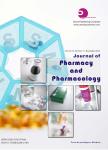Inactivation of Protein Tyrosine Phosphatase 1B (PTP1B) Activity by the Aqueous Partition of Guava Leaf Extract
Inactivation of Protein Tyrosine Phosphatase 1B (PTP1B) Activity by the Aqueous Partition of Guava Leaf Extract作者机构:Department of Biotechnology Asia University 500 Lioufeng Rd. Wufeng District Taichung 413 Taiwan Department of Nutrition China Medical University 91 Hsueh-Shih Rd Taichung 404 Taiwan Genomics Research Center Academia Sinica 128 Section 2 of Academia Rd Nankang District Taipei 115 Taiwan Division of Endocrinology and Metabolism Department of Medicine China Medical University Hospital Taichung Taiwan School of Chinese Medicine China Medical University Taichung Taiwan Asia University Hospital Wufeng Taichung College of Medicine Chung Shan Medical University 110 Section 1 of Jianguo North Rd Taichung 402 Taiwan Department of Pediatrics Chung Shan Medical University Hospital 110 Section 1 of Jianguo North Rd Taichung 402 Taiwan Department of Health and Nutrition Asia University 500 Lioufeng Rd. Wufeng District Taichung 413 Taiwan
出 版 物:《Journal of Pharmacy and Pharmacology》 (药剂与药理学(英文版))
年 卷 期:2018年第6卷第10期
页 面:890-906页
学科分类:0710[理学-生物学] 071010[理学-生物化学与分子生物学] 081704[工学-应用化学] 07[理学] 08[工学] 0817[工学-化学工程与技术] 0713[理学-生态学]
主 题:Guava leaf extract hypoglycemic oxidative protein tyrosine phosphatase 1b slow inactivation.
摘 要:Guava leaf tea has been used as a folk medicine for treating hyperglycemic conditions in Asia and Africa. The hypoglycemic efficacy of guava leaf has been documented by many scientists in these regions, but the hypoglycemic mechanism is poorly understood. Guava leaves were extracted with methanol and the crude extract was partitioned against hexane, ethyl acetate, and butanol in sequence. The leftover in water is defined as the aqueous partition. A second smaller batch was extracted with hot water directly. Oral glucose tolerance test was carried out on healthy mice instead of diabetic mice that lack endogenous insulin. Glucose uptake was examined with 3T3-L1 adipocytes. Oxidative effect on PTP1B (protein tyrosine phosphatase 1b) was carried out with real-time PTP1B enzymatic assay. The aqueous partition of guava leaf extract possesses a potent inhibitory effect on PTP1B enzymatic activity and this PTP1B inhibition is through a slow oxidative but reversible inactivation on the enzyme. The reversible inactivation would suggest guava leaf extract may augment PTP1B inhibition alongside the endogenous H2O2 which itself is induced by insulin. In addition, our study confirmed the hypoglycemic efficacy being associated with guava leaf and found the most effective molecules reside in the aqueous partition which is also less cytotoxic to Chinese hamster ovary cells when compared to other less polar partitions. The guava leaf extract can modulate insulin activity through a redox regulation on PP1B enzymatic activity. It is speculated that a compound similar to gallocatechin in the aqueous partition can reduce an oxygen molecule to hydrogen peroxide which in turn oxidizes the catalytic residue Cys in PTP1B. Therefore, the guava leaf tea can serve as a functional hypoglycemic drink that is suitable for either healthy or diabetic subjects.



